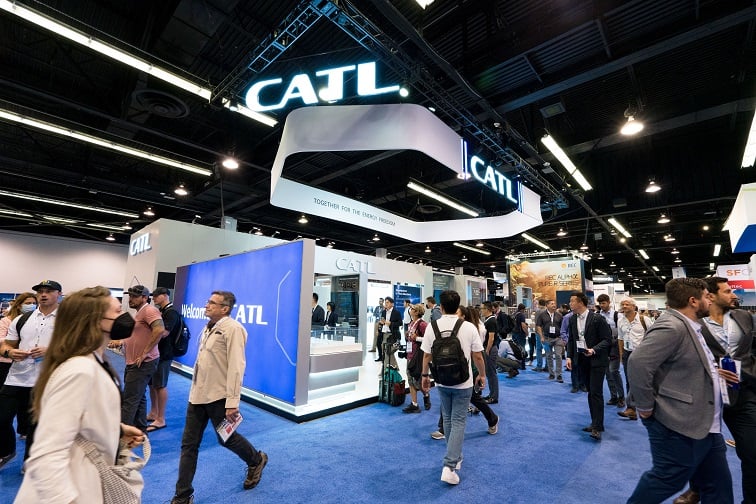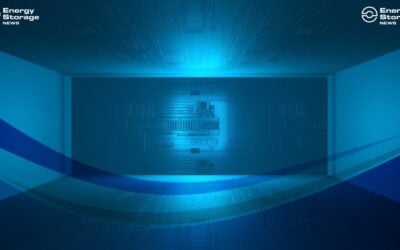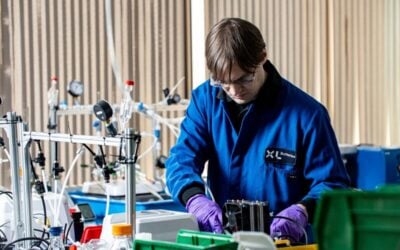
The US energy storage market’s rapid upward growth trajectory is going to lead to further scrambles for available battery supply, leading many to consider alternative technologies to lithium-ion.
That was the view of several sources at last week’s RE+ 2022, the US’ biggest clean energy tradeshow.
Wärtsilä Energy’s head of energy storage and optimisation Andy Tang said in an interview that his division of the Finnish energy and marine power solutions provider had had an “amazing year” in 2021, before supply chain issues brought it back down to earth.
After starting 2022 brightly, like many if not all in the industry, supply chain issues hit Wärtsilä, leaving it unable to supply its integrated lithium-ion battery storage solutions at contracted prices, leading to what Tang described as a process of cascading renegotiations with customers.
Try Premium for just $1
- Full premium access for the first month at only $1
- Converts to an annual rate after 30 days unless cancelled
- Cancel anytime during the trial period
Premium Benefits
- Expert industry analysis and interviews
- Digital access to PV Tech Power journal
- Exclusive event discounts
Or get the full Premium subscription right away
Or continue reading this article for free
“We all of a sudden found in ourselves in a position where we had no battery supply,” Tang said, in a market where lithium carbonate prices had shot up 500% in one year.
While he believes the industry as a whole did a good job of coping with the changes, with most technology providers introducing raw material indexed (RMI) pricing, it was a long process of more than six months to work through and come up with mitigation strategies and negotiate with customers.
As reported last week, Sara Kayal, head of PV integrated solutions at solar developer Lightsourcebp in a panel discussion at RE+ pointed out that the industry’s current modus operandi of relying on mostly the same battery supply chains as electric vehicles (EVs), isn’t really working out.
That is becoming one of the drivers for companies like Lightsourcebp to further examine non-lithium alternatives, Kayal said, a view echoed in an interview with Fluence’s VP of marketing and head of growth Kiran Kumaraswamy.
“In general, the volatility in lithium pricing has sparked a renewed type of interest on the non-lithium technology side,” Kumaraswamy said.
Fluence has a team working under its CTO that evaluates promising technologies, their characteristics and how they could fit market needs. But of course, competing with the most mature and therefore most bankable advanced battery technology isn’t easy for emerging tech.
IRA could exacerbate supply chain constraints
A lot of excitement felt around the US industry right now is centred on the Inflation Reduction Act (IRA) and the positive, transformative impact it is expected to have on the clean energy industry.
In the short term however, the boost in demand – which some have forecast will lead to doubling of battery storage deployments – is likely to put more constraints on already constrained industry supply chains, according to Jamal Burki, president at another utility-scale battery energy storage system (BESS) integrator, IHI Terrasun.
Burki emphasises the positives of the IRA’s expected impact but says it could create a lot of stress. IHI Terrasun to date has worked with the handful of Tier 1 battery suppliers. At the moment, these are mostly sold out for at least the next two years.
“For this thing to work, there have to be additional battery suppliers that are viable. We start to see a couple that have come in, like Gotion is one that has entered and are pledging to have actual manufacturing put in the US that is dedicated to energy storage systems, and SK has made some announcements as well,” Burki said.
However, IHI Terrasun expects it will be at least three years before additional suppliers’ batteries come onto the market in large volumes.
The company is therefore looking in the short term to see if there are battery technologies that are not as bankable or haven’t been around as long as lithium-ion that could be de-risked enough to use in the next couple of years.
‘We’re the capacity that is not prioritised’
Wärtsilä’s Andy Tang said that for a long time, he believed “lithium-ion has kind of won the war” of battery technologies. In our interview, he said he has now changed his mind.
While lithium-ion costs declined year-on-year for over a decade, Tang couldn’t see how a new technology could break into the market at scale. Today however, although raw materials prices’ sharp increase has slowed, they are still elevated above what they were and there is now more awareness in the industry about supply chain risks.
“I think we’re less than 10% of the of the lithium-ion battery market, where electric vehicles are 90%. We’re the marginal capacity, and we’re the capacity that is not prioritised. All the EV capacity is clearly prioritised, and then we’re the marginal stuff that gets sold on the end,” Tang said.
“It’s not a great place to be when you’re trying to establish a really nice, stable business, and then couple that with the fact that EV penetration has gone significantly higher than anyone actually anticipated, especially in the States.”
Price increases “have really opened the door for other technologies,” as has the lack of available lithium supply coming out of the ground and being refined. It could also be an opportunity to see if there are greener and lower carbon solutions than Li-ion, with lower toxicity at end of life.
“Even if it is maybe temporary in terms of two to three years, the price dislocation and the awareness that this has given the general community that there is a lithium shortage, [that] we are second fiddle to EVs, makes people wonder: is there something else we should be looking at?”
Both Kiran Kumaraswamy and Andy Tang were tight-lipped as to what some of the most promising alternative technologies could be. Jamal Burki said that IHI Terrasun has been in “close discussions” with an undisclosed sodium battery company.
He offers a note of caution however that any alternative technologies themselves face a big challenge in building up their own supply chains, scaled production and bankability credentials to gain market traction.


![burns and mcdonnell GA_Battery_Storage_003[84] The maturing industry has allowed EPCs to "get more creative with engineering technology and construction equipment to help streamline operations in the field," Julian Hoover says. Image: Burns & McDonnell](https://www.energy-storage.news/wp-content/uploads/elementor/thumbs/burns-and-mcdonnell-GA_Battery_Storage_00384-rgklnp65oz5okwj4j525f5bdz9y57j338jh6zpqdvo.jpg)


